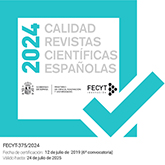Voice re-education and its evaluation through digital signal processing: A case study
DOI:
https://doi.org/10.3989/loquens.2017.040Keywords:
voice, vocal rehabilitation, vocal technique, Cimardi Method, the Cellophane Screen, neurodegenerative disease, myasthenia gravisAbstract
Voice pathologies, caused either by functional dysphonia or organic lesions, or even by just an inappropriate emission of the voice, may lead to vocal abuse, affecting significantly the communication process. The present study is based on the case of a single patient diagnosed with myasthenia gravis (Erb-Goldflam syndrome). In this case, this affection has caused, among other disruptions, a dysarthria. For its treatment, a technique for the education and re-education of the voice has been used, based on a resonator element: the cellophane screen. This article shows the results obtained in the patient after applying a vocal re-education technique called the Cimardi Method: the Cellophane Screen, which is a pioneering technique in this field. Changes in the patient’s voice signal have been studied before and after the application of the Cimardi Method in different domains of study: time-frequency, spectrum, and cepstrum. Moreover, parameters for voice quality measurement, such as shimmer, jitter and harmonic-to-noise ratio (HNR), have been used to quantify the results obtained with the Cimardi Method. Once the results were analyzed, it has been observed that the Cimardi Method helps to produce a more natural and free vocal emission, which is very useful as a rehabilitation therapy for those people presenting certain vocal disorders.
Downloads
References
Alonso Hernández, J. B., Travieso González, C. M., Ferrer Ballester, M. Á., y Godino Llorente, J. I. (2008). La evaluación acústica del sistema fonador. Las Palmas de Gran Canaria: Universidad de Las Palmas de Gran Canaria.
Alonso, J. B., Ferrer, M. A., de León, J., y Travieso, C. M. (2006). Cuantificación de la calidad de la voz para su evaluación clínica por medio del análisis acústico. IV Jornadas en Tecnología del Habla, 203-208.
Audacity, editor de audio libre (2015). [Programa de ordenador]. Disponible en http://audacity.es/
Boersma, P., y Weenink, D. (2015). Praat: doing phonetics by computer [programa de ordenador]. Disponible en http://www.praat.org
Bustos, I. (2003). La voz. La técnica y la expresión. Badalona: Paidotribo.
Calvo-Manzano Ruiz, A. (1993). Acústica físico-musical. Madrid: Real Musical-Carrisch.
Canuyt, G. (1958). La voz: Técnica vocal. Tomo 1. Buenos Aires: Librería Hachette.
Cobeta, I., Núñez, F., y Fernández, S. (2013). Patología de la voz. Madrid: Marge.
Huckvale, M. (2015) ESection. Windows Tool for Spectral Crosssections. UCL Psychology and Language Sciences. Disponible en http://www.phon.ucl.ac.uk/resource/sfs/esection/
Le Huche, F., y Allali, A. (1993). La voz. Tomo 2. Barcelona: Masón.
Santana López, M. Z. (2015). Análisis acústico de la misión vocal a través de un elemento resonador: Pantalla de Celofán [Tesis doctoral]. Universidad de Las Palmas de Gran Canaria. PMid:25074034
Published
How to Cite
Issue
Section
License
Copyright (c) 2017 Consejo Superior de Investigaciones Científicas (CSIC)

This work is licensed under a Creative Commons Attribution 4.0 International License.
© CSIC. Manuscripts published in both the print and online versions of this journal are the property of the Consejo Superior de Investigaciones Científicas, and quoting this source is a requirement for any partial or full reproduction.
All contents of this electronic edition, except where otherwise noted, are distributed under a Creative Commons Attribution 4.0 International (CC BY 4.0) licence. You may read the basic information and the legal text of the licence. The indication of the CC BY 4.0 licence must be expressly stated in this way when necessary.
Self-archiving in repositories, personal webpages or similar, of any version other than the final version of the work produced by the publisher, is not allowed.














